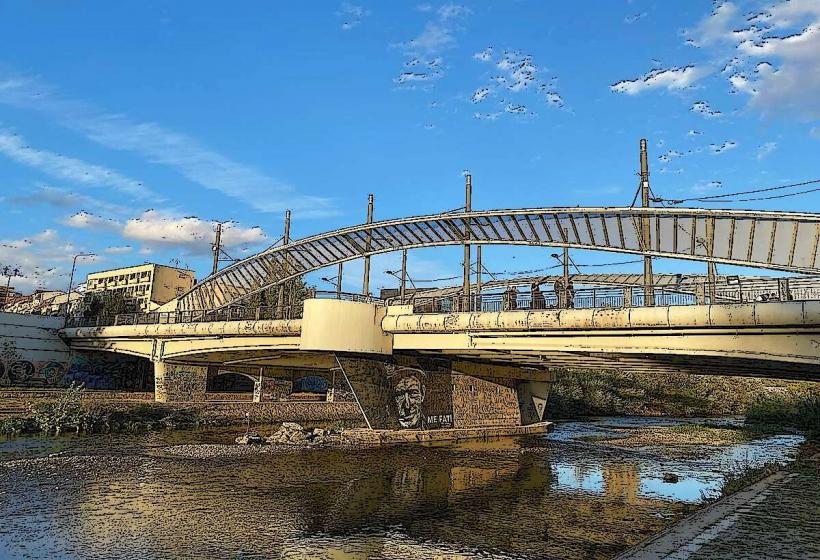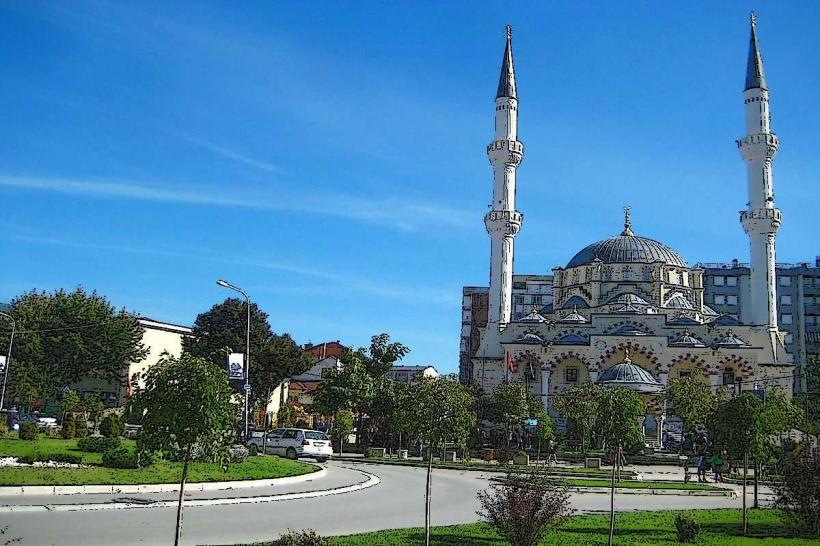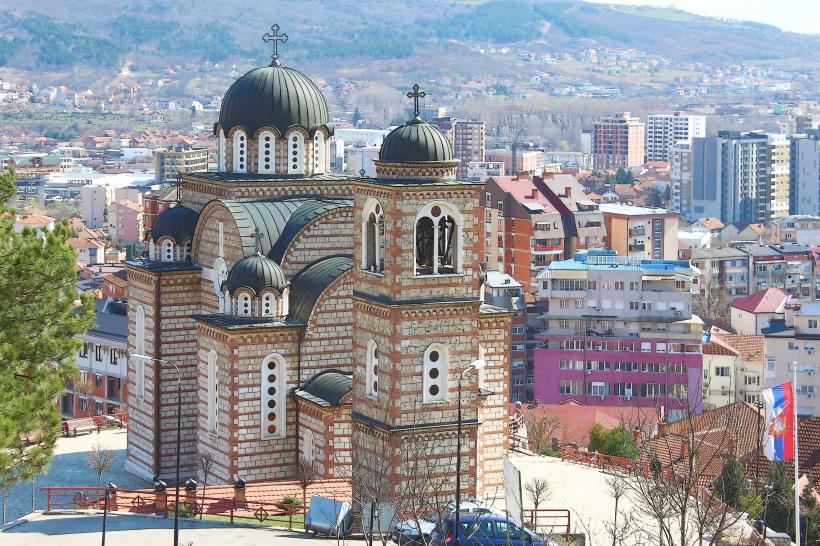Information
City: Kosovska MitrovicaCountry: Kosovo
Continent: Europe
Kosovska Mitrovica is one of Kosovo's most significant cities, both historically and politically, located in the northern part of the country. It lies on the banks of the Ibar River, with the city split by the river into two distinct parts: the north, which is predominantly Serb, and the south, which is predominantly Albanian. This division is a result of the complex political situation in Kosovo, particularly following the Kosovo War (1998–1999) and the subsequent declaration of independence in 2008.
Geography and Location
Kosovska Mitrovica is situated in the Mitrovica District of Kosovo, near the border with Serbia. The city's strategic location at the crossroads of the Ibar River has made it a historically important center of trade and culture. The division between the north and south parts of the city reflects the broader ethnic and political divisions within Kosovo and its surrounding regions.
History
Kosovska Mitrovica has a rich and complex history that dates back to Roman times. The city's historical evolution has been influenced by various empires and cultures, including the Roman Empire, Byzantine Empire, Ottoman Empire, and Yugoslavia, each of which left its mark on the town.
Roman and Byzantine Periods: The area around Kosovska Mitrovica was inhabited by Illyrians and later became part of the Roman Empire. The city was an important Roman settlement, with evidence of Roman architecture and artifacts uncovered in the region.
Ottoman Period: Kosovska Mitrovica, like much of Kosovo, was part of the Ottoman Empire from the 15th century. The Ottomans built several important structures in the town, including mosques and bridges, and their influence is still evident in the city's architecture.
Modern Era and the Kosovo War: Kosovska Mitrovica has been at the heart of ethnic and political tensions in Kosovo. After the breakup of Yugoslavia and the Kosovo War, the city became a focal point of conflict. Following the war, the city became divided along ethnic lines, with the northern part of the city remaining under Serb control and the southern part coming under Albanian control. The city’s division persists today, with tensions between ethnic Albanians and Serbs continuing to play a role in local and regional politics.
Cultural and Ethnic Composition
Kosovska Mitrovica has a diverse cultural makeup, reflecting its historical complexity. The ethnic makeup of the city is divided primarily between Serbs in the north and Albanians in the south. There are also smaller communities of Bosniaks, Gorani, and other ethnic minorities.
North Kosovska Mitrovica: This part of the city is predominantly Serb, with a significant Serbian Orthodox population. The north is largely influenced by Serbia, with many institutions, businesses, and services aligned with Serbian administration and governance. The town's Serb population is very supportive of the political position that Kosovo is part of Serbia.
South Kosovska Mitrovica: The southern part of the city is predominantly Albanian, with a strong ethnic Albanian presence. The south has a closer connection to the Kosovo Government and is part of the internationally recognized Kosovo Republic. The southern side is where most of the Albanian culture, business, and education are centered.
Landmarks and Attractions
Kosovska Mitrovica features several landmarks and historical sites that reflect its complex history and diverse culture:
Ibar River Bridge: The Ibar River Bridge is a symbol of the division of Kosovska Mitrovica. It crosses the Ibar River, connecting the northern and southern parts of the city. While it serves as a vital transportation link, it has also become a symbol of the ongoing ethnic and political division in Kosovo.
The Mitrovica Fortress: The remains of an ancient fortress overlooking the town are a testament to the city’s long history. The fortress dates back to Roman times, and it offers a panoramic view of the city and the surrounding region. It is believed to have been part of the defensive network of the ancient Roman city of Municipium Dardanicum.
Saint Demetrius Church: Located in the north, this Serbian Orthodox Church is a significant religious landmark for the Serb community. The church, like others in the region, has faced challenges due to the political and ethnic tensions in the area.
The Albanian National Library: Located in the southern part of the city, this library is a hub for the Albanian community in Kosovo. It serves as a center of culture and education for Albanians in the region.
Ethnological Museum: The museum in the city offers insight into the history, culture, and traditions of the various ethnic groups that have lived in the region. It is a key site for learning about the multicultural heritage of Kosovska Mitrovica.
Kosovo’s University of Mitrovica: Located on the southern side of the city, this university is an important educational institution in Kosovo, offering programs in various disciplines.
Political and Social Context
Kosovska Mitrovica remains one of the most politically sensitive cities in Kosovo. The division of the city reflects the broader ethnic and political divisions within the country, and the area is often a site of tension between ethnic Albanians and Serbs.
Serb-Albanian Relations: Relations between the ethnic communities in Kosovska Mitrovica are tense, with frequent protests, demonstrations, and clashes, particularly related to the sovereignty of Kosovo. The Serb population in the north does not recognize Kosovo's independence, and many still consider Kosovo to be a part of Serbia.
International Presence: The city is under the administration of the United Nations Mission in Kosovo (UNMIK), which oversees the implementation of Kosovo’s independence and works to maintain peace and security in the region. There is also a European Union (EU) mission that helps to facilitate dialogue and cooperation between ethnic communities.
Modern-Day Kosovska Mitrovica
Despite the political challenges, Kosovska Mitrovica is a city of economic and cultural significance in Kosovo. The economy is based on industry, trade, and services, with significant sectors in mining (historically, the region was a major mining center) and manufacturing.
The city continues to face significant challenges related to ethnic relations, political divisions, and economic development. However, efforts for reconciliation, such as the EU-mediated Belgrade-Pristina dialogue, aim to improve relations between ethnic Albanians and Serbs and bring about peace and stability in the region.
Conclusion
Kosovska Mitrovica is a city shaped by a rich history, deep-rooted ethnic divisions, and ongoing political challenges. The city's landmarks, from its ancient fortresses to its religious buildings, tell the story of its complex past. Despite the difficulties posed by its divided nature, Kosovska Mitrovica remains an important cultural and economic center, continuing to reflect the broader issues facing Kosovo as it navigates its path to peace and prosperity.




